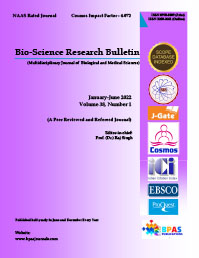Production and Stability Studies of the Biosurfactant Isolated from Alkaliphilic Bacterium SJS1
DOI:
https://doi.org/10.48165/Keywords:
Haloalkaliphiles, Biosurfactant, Bioremediation, SJS1Abstract
Background: Mostly oil spills occurs in sea ocean and coastal areas, required the best candidate for the degradation of hydrocarbons such as chemical surfactant and synthetic chemicals to minimize such oil spills are primarily effective strategies with environmental risk so the aims of these studies the isolation and characterization of a alkaline and halotolerant bacteria which was isolated from Lonar Crater and able to utilize different oil as carbon source and produces biosurfactant. Methodology: In present investigation was to determine surfactant substance producing bacterium of Lonar Lake using minimal salt medium with various oil as a carbon sources. Biosurfactant-producing microorganisms were isolated and screening was done on the basis of Drop collapse test, Oil spread and emulsification index. Result: A total of six bacteria were isolated from the water and sediment samples collected from the of Lonar crater, India. Out of them SJS1was selected for production and, partial characterizations of biosurfactant. A Gram negative bacterium was studied by morphological, physiological and biochemical characterization. The bacterium SJS1 grew in medium containing sodium chloride (NaCl w/v) from 0.5 to 7% and at pH 7–12. The production of a biosurfactant by Bacteria SJS1 was studied to evaluate the influence of the concentration of different oil. SJS1 was able to grow at high salinity conditions and produce biosurfactants. The organism grew and produced biosurfactant when cultured in salinities up to 3 g l-1and temperatures up to 60°C. The biosurfactant was highly stable over broad temperature, pH and NaCl, showing excellent thermostablity, and haloalkaline tolerant nature. The biosurfactant produced by the organism emulsified a range of oil with as Ground nut and Coconut oil best substrate whereas Sesame oil was the poorest. Interpretation: This is valuable information for biosurfactant production and optimization has bright future towards the improvement and production of novel biosurfactant for entirely new areas of environmental and biotechnological applications. The results confirmed, their enhancing capability on both efficiency and rate of hydrocarbon degradation from water and soil.
References
Augustine, S.K., S.P. Bhavsar, B.P. Kapadnis: A non-polyene antifungal antibiotic from Streptomyces albidoflavus PU 23. J. Biosci.,30:201-211 (2005)
Das, P., S. Mukharjee, R. Sen: Antimicrobial potential of a lipopeptide biosurfactant derived from a marine Bacillus circulans, J. Appl. Microbiol 104:1675-1684. Doi:10.1111/j.1365- 2672.2007.03701 (2008)
Desai, J.W., I.M. Banat: Microbial Production of Surfactants and Their Commercial Potential, Microbial. Mal. Rev., 61,47-64 (1997)
Ferraz, C., A.A. DeAraujo, G.M. Pastore: The Influence of Vegetable Oils on Biosurfactant Production by Serratia marcescens, Appl. Biochem. Biotechnol, 98-100:841-847 (2002) 5. Fiechter, A.: Biosurfactants: Moving Toward Industrial Application, Trends in Biotech.,10,208-217 (1992)
Ghazali, R., S. Ahmad, Bisurfactants-A Review, Elaeis 9(1),34-54 (1997)
Imasda, C: Enzyme inhibitors and other bioactive compounds from marine and Actinomycetes. Antonie Van Leewenhoek,87:59-63(2005)
Joshi, A.A., P.P. Kanekar, A.S. Kelkar, Y.S. Shouche, A.A. Vani, S.B. Borgave, S.S. Sarnaik: Cultivable bacterial diversity of alkaline Lonar Lake, India. Microbial Ecology, 55(2):163-172 (2008)
Khopade, A., R. Biao, X. Liu, K. Mahadik, L. Zhang, and C. Kokare: Production and stability studies of the biosurfactant isolated from marine Nocardiopsis sp. B4. Desalination, 285:198-204 (2012)
Koch, A.K., J .Reiser, O. Kappeli, and A. Fechter: Genetic construction of lactose-utilizing strains of Pseudomonas aeruginosa and their application in biosurfactant production. Bio/Technology 6:1335-1339(1988)
Kumar, M., V. León, A. De Sisto Materano, O.A. Ilzins, L. Luis: Biosurfactant production and hydrocarbon-degradation by halotolerant and thermotolerant Pseudomonas sp. World Journal of Microbiology and Biotechnology, 24(7):1047-1057 (2008)
Mukharjee, S., P. Das, R. Sen: Towards commercial production of microbial surfactants. Trends Biotechnol. 24:509-515 (2006) PubMeddoi: 10.1016/j.tibtech.2006.09.005.
Mulligan, C.N., T. N. Yong, B. F. Gibbs: Environmental Application for Biosurfactants. Environ. Poll., 133(2),183 (2001)
Olivera, N.L., L.N. Marina, M. Lozada, G. Del Prado, H.B. Dionisi, F. Sineriz: Isolotion and characterization of Biosurfactant producing Alcanivorax strains: Hydrocarbon accession strategies and alkane and hydroxylase gene analysis. Res Microbial160:19-26. Doi: 10.1016/ j.resmic.2008.09.011 (2009)
Oskay, M., A.U. Tamer, C. Azeri: Antibacterial activity of some actinomycetes isolated from forming soils of Turkey. Afr. J. Biotechnol., 3:441-446 (2004)
Ran, E.Z., E. Rasenberg: Natural roles of biosurfactants. Environ. Microbial. 3:299-236 (2001). PubMed doi:10.1046/j.1462-2920.2001.00190.x.
Richter, M., J.M. Willey, R. Submuth, G. Jung, and H.P. Fiedler: Streptofactin, a navel biosurfactant with aerial mycelium inducing activity from Streptomyces te18. Sasidharan, V., J.J. Thambirajah, C.C. Ho, M.A. Hasyim: Microbiandae Tu 901/8c.FEMS. Microbial Lett. 163:165-171 (1998)
l Production of Biosurfactants from Palm Oil by Candida bombicola, The 16thMalaysian Microbiology Symposium,62-64. (1993)
Silva, C.F., R.F. Schwan, E.S. Dias, A. E. Wheals: Microbial diversity during maturation and natural processing of natural coffee cherries of Coffea Arabica in Brazil. Int J Food Microbiol 60:251-260. (2000)
Tambekar, D.H. V.R. Dhundale: Studies on the physiological and cultural diversity of bacilli characterized from Lonar lake (MS) India. Biosci Discov, 3(1):34-39 (2012)
Tambekar, D.H., P.N. Dose, S.R. Gunjakar, P.V. Gadakh: Studies on biosurfactant production from Lonar Lake’s achromobacter xylosoxidans bacterium. International journal of advances in pharmacy. Biology and chemistry, 1(3):415-419 (2012)
Thavasi, R., S. Jayalakshmi, T. Balasubramanian, I.M. Banat: Production and characterization of a glycolipid biosurfactant from Bacillus megaterium using economically cheaper sources. World Journal of Microbiology and Biotechnology, 24(7):917-925 (2008)
Vasileva-Tonkova, E., A.Sotirova, D. Galabova: The effect of rhamnolipid biosurfactant produced by Pseudomonas fluorescens on model bacterial strains and isolates from industrial wastewater. Current microbiology, 62(2):427-433.( 2011)
Yakimov, M.M., P.N. Golyshin, S. Lang, E.R.B. Moore, H. Lunsdorf, K.N. Timmis: Alcanivorax borkumensis now.sp.nov., a new , hydrocarbon degrading and surfactant producing marine bacterium, Int J SystBacteriol 48:339-348 (1998)
Youssef, N.H., K.E. Duncan, D.P. Nagle, K.N. Savage, R.M. Knapp, M.J. McInerney: Comparison of methods to detect biosurfactant production by diverse microorganisms. Journal of microbiological methods, 56(3):339-347(2004)
